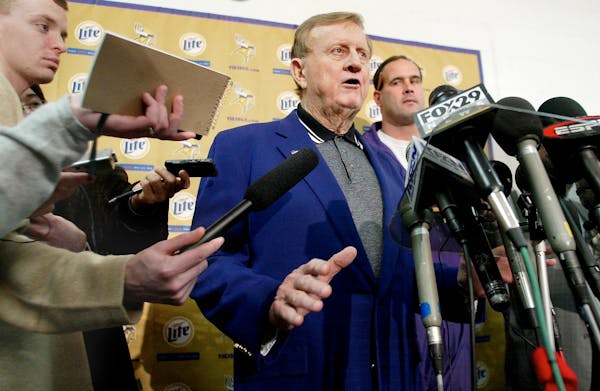In 1962, 14 NFL teams drafted 280 players over 20 rounds. Twenty centers were selected. Mick Tingelhoff was not.
In 1990, 28 NFL teams drafted 331 players over 12 rounds. Fifteen defensive tackles were selected. John Randle was not.
Two months ago, Malcolm Butler became the last-second hero of the 2015 Super Bowl. A rookie. Wasn't drafted.
James Harrison, Antonio Gates, Tony Romo, Wes Welker, Victor Cruz. Pro Bowl stars and superstars. Not a single one drafted.
So, yeah, NFL teams take their undrafted rookie signing periods quite seriously.
"That's the most hectic time of the whole draft weekend," Vikings General Manager Rick Spielman said. "You're signing and negotiating and recruiting 15 to 20 more players in a three- or four-hour period. Out of the whole year, that is the most hectic time of organized chaos there is when it comes to adding players."
After the Vikings make their final pick at 232nd overall, there will be 24 more selections until the draft ends. During that time, Spielman will stack the free-agent board based primarily on the number of players coach Mike Zimmer has said he needs at each position for training camp.
"But there also are times when we'll have all the players we need at a position, but we'll look at our board and say, 'I can't believe this guy is a college free agent. Let's go get him,' " Spielman said. "In that case, you get him and cut someone else."
Managing the organized chaos takes a team effort by the coaching and scouting staffs. As soon as the draft ends, roughly 30 men take to the phones with specific instructions on who to call and how much to offer in signing bonuses.
Under the new collective bargaining agreement, teams are allowed to spend only $83,000 in signing bonuses for their entire undrafted rookie class. The Vikings set financial parameters for each player they call. Some are $1,000 to $3,000. Some are up to $5,000. Some are up to $7,000.
"We've gone over that to get a guy, but whoever is on the phone has to come to us and get the OK first," Spielman said. "There are a lot of moving parts. You're going crazy trying to get a hold of the player. You're going crazy trying to get a hold of the agent. And they may be tied up with another team, so you move on to the next guy on your list."
Unlike the draft, the players get to decide where they want to go. The competition can become intense. Before the new CBA limits, teams were spending $25,000 on some signing bonuses.
"But what you're seeing teams doing now is saying, 'OK, I can't give you the $25,000 signing bonus, but I'll guarantee $25,000 in your base contract in your paragraph five," Spielman said. "You're seeing different ways of teams manipulating that rule."
Phone etiquette sometimes takes a back seat to the organized chaos.
"A guy may be on the phone with two, three, four players at the same time," Spielman said. "And all of a sudden, someone else will get a guy and fill our need at a position. And we're saying, 'We don't need that guy, get off the phone with him and move on to the next one.'"
When one of the coaches or scouts lands a verbal commitment from a prospect, he brings it to Spielman and Rob Brzezinski, the team's executive vice president of football operations and salary cap expert. They post it on the board and the process moves on to Anne Doepner, Brzezinski's assistant, who handles the paperwork.
"You're trying to get signatures as fast as you can," Spielman said. "I've had verbals a few times where I'm getting ready to walk out of the building and the guy backs out and signs with another team.
"You can't trust some verbals. Most of the agents, you can honor their word. And the ones you get burned on, they go on the list. A specific list I'll call a 'non-trustworthy' list."
Last year, the Vikings had six players on their 53-man roster who had joined them as college free agents in recent years. Six more had entered the league in recent years as college free agents with other teams.
"We work as hard trying to get to know these guys as anyone else," Spielman said. "You want to be ready. The draft is pretty calm. But when the draft ends is when it's not so calm."
Mark Craig • mcraig@startribune.com
Brittney Griner still adjusting after Russian prison ordeal. WNBA star details experience in book
Premier League referee to wear camera to offer insight into demands of being a match official
Tom Brady's Netflix roast features lots of humor, reunion between Robert Kraft and Bill Belichick
Diamondbacks end 3-game losing streak, pound Padres 11-4

